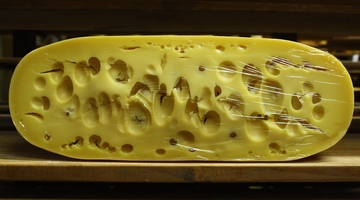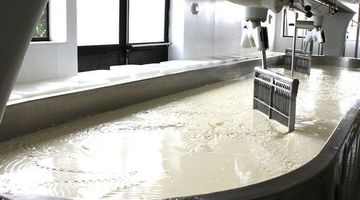In this interactive Miel Meyer explains some of the processes for managing cheese quality in making traditional Gouda cheese. Click on the labels to watch the videos and for more information.
Select here to view the full transcript and copyright information.

In this interactive Miel Meyer explains some of the processes for managing cheese quality in making traditional Gouda cheese. Click on the labels to watch the videos and for more information.
Transcript
Testing milk quality
Miel Meyer – Meyer Gouda Cheese
With the farm being both a Fonterra supplier as well as supplying milk for ourselves, we get a third-party test through Fonterra, so Fonterra regularly test the milk for the milk solids component, how much water and that sort of thing. We also have our own tests for the milk which is pH, which is quite crucial, as well as the cleanliness test, which is basically running milk through a filter to see how clean it is. And again, having the local supplier means if there is a problem, we can talk to the farmer about it, get those problems sorted out really quickly.
Each day’s milk is different to the next, so as soon as the milk starts pouring into the vat, we can say a) does it look good, is it clean, is it fatty? So if it’s fatty, all of a sudden I know straight away I’m going to have to mix for longer, it’s going to be harder to draw the moisture out. It’s one quality control check.
Milk pH test
Miel Meyer – Meyer Gouda Cheese
So we do two pH tests at the cheese factory. One is in relation with the milk, so we add the starter bacteria. We need to prove to the New Zealand Food Safety Authority that acidity is actually taking place, so traditionally, we check the colour change at the end of the day so we’re happy the bacteria have grown.
I need to prove that by doing a pH test throughout the day, so one in the morning when the fresh milk’s pouring into the vat, one in the middle of the day just after the cutting and one later at the end of the day with the whey. And then I should be able to show a general decline in the pH.
Testing coagulum before cutting
Miel Meyer – Meyer Gouda Cheese
So we know when the cutting is ready to start once the milk splits consistently and cleanly. The crucial factor is, is just like when you test a cake, put the knife in, check if there’s nothing left on the knife. It’s very similar – we put a blade into the milk, into the coagulant, and we’ll see how it splits. You should see a nice clean split. When you pull the blade out, there should be no leftover residues on the blade and then that way you know that the milk is quite ready.
Testing curds before moulding
Miel Meyer – Meyer Gouda Cheese
The feeling of the curds is probably the biggest factor. If it’s too soon and you’re pressing the curds too soon, you end up with a really moist cheese, and you’ve got the potential that it goes off much quicker. Bacteria love moisture and heat, and you don’t want the moisture in the cheese – a little bit, yes, but not too much.
The curd size is another one of those quality control checks to make sure it’s small enough for the type of cheese we’re making. To test the curds, I put the curds in my hand, feel it. If it breaks up easily, then the curds will be ripe for moulding. Again, it depends on the type of cheese – if it’s a old or vintage cheese, then you need a really dry curd, so it should never stick to, to itself. A really mild creamy cheese, then you have a bigger curd and it sticks a lot more.
Milk temperature checks
Miel Meyer – Meyer Gouda Cheese
Other things like temperature checks – so we increase the temperature throughout the day so the curds mature correctly. Those temperature checks are recorded as well, if they haven’t or have reached temperature, then those are the quality control checks that we can check on.
Testing cheese before brining
Miel Meyer – Meyer Gouda Cheese
Once you’ve pressed the cheese, we put it onto the table to just sit and rest to let the bacteria keep growing. Eventually later on in the evening, you’ll see a colour change in the cheese. It’s not visible for the average person, but if you’re trained, you’ll see these changes, and that’s when we know it’s ready for the brining. The pH has reached a good level.
The brining helps reduce the rate at which the bacteria are growing, it slows down that pH reduction. And that’s why we need to make sure the pH has been achieved before we brine it, because if you brine it too soon, then it’s going to be much harder for the cheese to reach the pH that we require, and then also the risk of spoilage of that cheese is increased.
With the New Zealand Food Safety Authority, which we’re a big part of obviously, we measure pH. So that’s reaffirming that our traditional methods of pH change are still viable, but for food safety reasons, we have to document those pH changes.
Brine testing
Miel Meyer – Meyer Gouda Cheese
With the brine, we do another pH test just to check that it’s about neutral pH, and that’s just to make sure that, at a certain pH, the rate at which salt is entering the cheese is the same. Again, we want to make a good quality cheese and it needs to be consistent, so if I have a consistent pH throughout the year, then the salt is consistently going into the cheese at the same rate, so the pH tests achieve that.
I also did a salinity test. The brine salinity tests lets us be aware of how much salt is actually in the brine, so we need to make sure that it’s saturated in salt so that the cheese can take on as much salt as it needs and previous and next batches that come through the salt all get the same amount of salt onboard.
Firmness test before brining
Miel Meyer – Meyer Gouda Cheese
At the end of the day is a firmness test on the cheese. So this was just to check the firmness of the cheese, sort of a quality control check for next day’s make. So you can’t do anything with that batch, but it lets you feel how much moisture’s been left in the curds, whether you‘re happy with that and whether you’d change anything for the next day. For instance, if it was too soft, it would be indicating to me there’s too much moisture, so the next day I’d want to make certain adjustments – say stirring longer or cutting the curd smaller – just to make sure that it wasn’t so soft.
Food safety – raw ingredients
Miel Meyer – Meyer Gouda Cheese
Possible food safety hazards would include the contamination of milk. At the start of the day, it’s held at 29 degrees, which is perfect for bacteria to grow, so that’s probably the biggest hazard. To overcome that hazard, we’ve got pasteurisation, so that’ll reduce the risk by taking out a lot of the bacteria that could be present in the milk to begin with.
Other hazards would be contamination via introducing them through the herbs or the starter bacteria or the rennet. We make sure we buy those products from reputable companies which have the processes in place to reduce those risks as well. And other things include sterilisation of the cumin seed – there’s a hand-held thermometer making sure it’s reached the 90 degrees to make sure it’s sterile.
Food safety – personal hygiene
Miel Meyer – Meyer Gouda Cheese
Personal hygiene is another key factor. We’re working with the milk, so it’s important for us as cheesemakers and helpers to make sure we’re clean ourselves. Wearing hairnets to prevent your hair falling in. It’s important that your hands are clean – we do get into the milk with our arms so it’s important they’re clean so you’re not introducing foreign bacteria. As the starter bacteria is growing initially, it still leaves room for foreign bacteria to grow as well.
Your clothing – obviously we don’t go onto to the farm, into the cowshed and then straight into the cheesemakery. We wear white gumboots, white shorts, white t-shirt. The reason it’s white is then you can see when it’s dirty – it’s cleaned every day – but if you had say a dark t-shirt, then you might not know if there’s something on there, so that’s why you call it your whites.
So there’s those strict rules in place, and usually during the staff training and when the staff first come to the cheese factory, those are the things that are talked about and from time to time re-explained if needed.
Food safety – sterilising equipment
Miel Meyer – Meyer Gouda Cheese
All the tools we work with get cleaned and sterilised before and after the day’s end. So right from the beginning of the day, the equipment is put through just an 80 degree hot water wash. So we’re just rinsing all the equipment with really hot water, so if there was anything on there from the previous day then it was going to be sterilised. We wash and rinse the moulds once they’ve come out of their bins, so there’s a solution in there which make’s sure they’re sterile. We rinse those so that the chemicals are gone and we can use them with the food product.
The hot wash is really important, so after making the cheese, all the equipment’s put into the vat, it’s filled up with really, really hot water and all washed down with stainless steel detergent, which is all specifically designed for the stainless steel equipment as well. So those are all key steps in making sure that the environment we work in is all sterile and clean.



